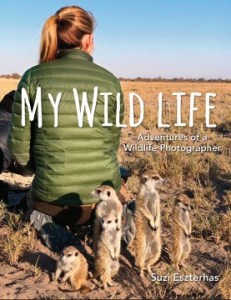 Lynn: Books for really young readers on careers are not easy to do well but a wildlife photographer/author that I especially admire, Suzy Eszterhas, has given us just that in My Wild Life: Adventures of a Wildlife Photographer (Owl Kids, 2020). This fascinating story comes with a real bonus as the pertinent information includes a bounty of wonderful photographs that clearly expand on the points being made in the text. Eszterhas confides that she wanted to be a wildlife photographer as a child and she spent many hours in her backyard photographing her cats and squirrels, practicing the skills she would need.
Lynn: Books for really young readers on careers are not easy to do well but a wildlife photographer/author that I especially admire, Suzy Eszterhas, has given us just that in My Wild Life: Adventures of a Wildlife Photographer (Owl Kids, 2020). This fascinating story comes with a real bonus as the pertinent information includes a bounty of wonderful photographs that clearly expand on the points being made in the text. Eszterhas confides that she wanted to be a wildlife photographer as a child and she spent many hours in her backyard photographing her cats and squirrels, practicing the skills she would need.
Taking readers through many of the fascinating and challenging aspects of her job, Eszterhas provides information about how she preps the shots, finds and allows animals to grow confident around her, some of the techniques she uses to get shots including lying for hours belly down to achieve eye-level pictures and even flying in small airplanes—which makes her throw up in between clicking the shutter. She doesn’t pull any punches about the conditions she often has to live and work in. Kids will love some of the details like having to pee in a bottle while in a camouflaged blind, living in a tent for months without a shower, or waking up with ticks in her nose. She stresses that patience and having to wait for hours is often the key to success. And it is clear that being a woman in this very male-dominated field takes courage and determination.
Each chapter is an accessible and appealing 2 pages, which is ideal for young readers and the clear text is as informative as it is interesting. Several chapters are about the local experts and the scientists she works with and explains about her dedication to giving back to organizations that help wildlife. A concluding chapter is titled “Ask Suzi” and it provides additional information to questions about the profession.
The terrific photographs will draw readers in starting with the cover which is a beguiling shot of a group of meerkats sheltering from the wind up against her back. This book is sure to be a winner with kids who love nature and animals or are budding photographers themselves. All of them will come away with a real grasp of the skills and hard work necessary for this fascinating career and a deeper appreciation for the outstanding work done by photographers like Eszterhas.
Cindy: Eszterhas is an inspiration. Not only is this book as well done as Lynn says, but Suzi is also donating a portion of her royalties to her nonprofit organization Girls Who Click, a group that “empowers teen girls to enter the male-dominated field of nature photography and use their work to further conservation efforts around the world.” The free nature photography workshops are available online due to the current COVID crisis, perfect for distance and virtual learners. I wish I could take one! If, like us, you can’t get enough of Eszterhas’ extraordinary wildlife photography visit her website for more images that will take your breath away.


 Lynn: I’ve seen a T-Shirt recently that proclaims, “I read. I know things.” I like that but what I want is a T-Shirt that says, “I didn’t know that!” I needed to wear that shirt when I read
Lynn: I’ve seen a T-Shirt recently that proclaims, “I read. I know things.” I like that but what I want is a T-Shirt that says, “I didn’t know that!” I needed to wear that shirt when I read